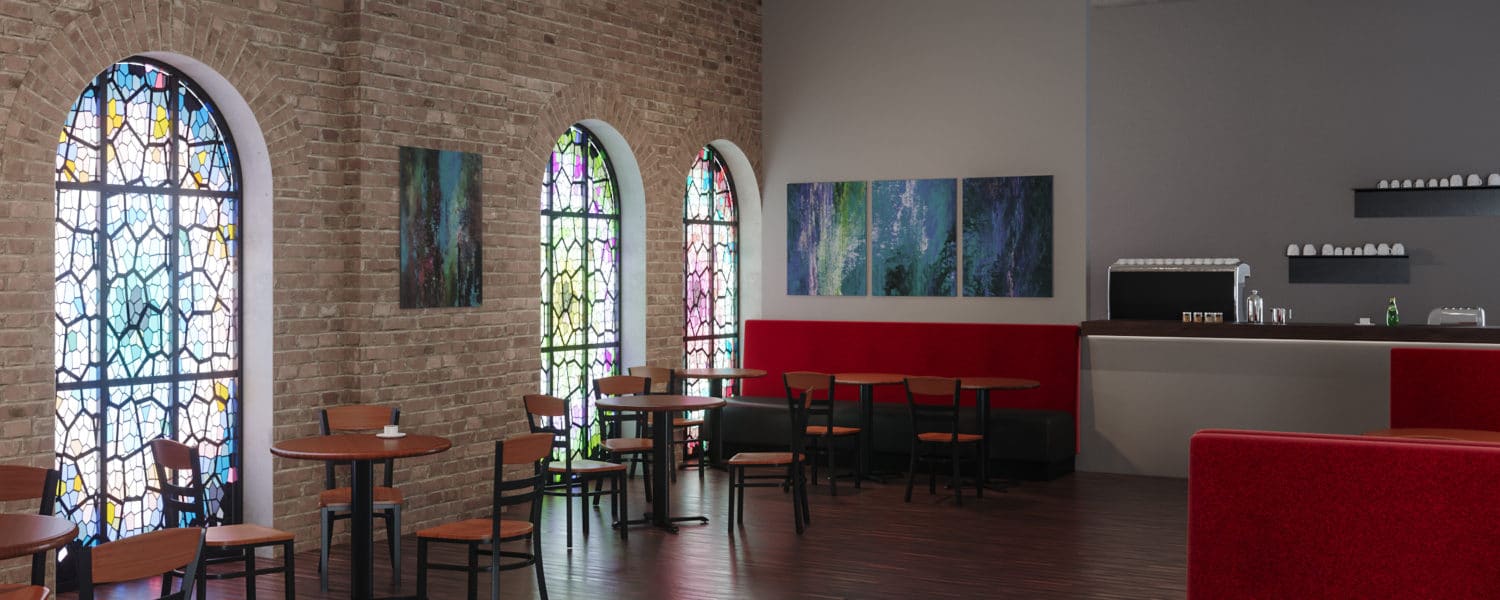By Steve Cohen
The key to creating a facility that adds value beyond Sunday lies in the design of public space—the areas where people meet, eat, learn and relax.
In the modern congregation, there are many types of public space, including lobbies, social halls, recreation rooms, youth lounges, coffee shops and corner nooks. While each of these locations serves a unique and specific purpose, there is a common goal to design them in the most appropriate manner to maximize their use.
This article looks at three key topics that help accomplish that goal:
- Zoning the space for effective use
- Types of furniture that support different requirements
- What to think about when specifying furniture
1. Zoning
Zoning is creating space within a space to allow a facility to cater to different functions and needs simultaneously, and it has become a mainstay in commercial design. To know how to zone a space, conduct a self-assessment, in which the following questions are asked:
- What are the demographics of the current membership? Are we trying to change it? If so, in what way?
- Who are we trying to attract to the space?
- What activities might take place in the space?
Let’s use the typical social hall as an example. It is used as a gathering place on Sunday and for adjunct meetings, lay leadership meetings, or as a place to hang out on the other days of the week.
Zones can be called by any name, but typically they need to be flexible in order to serve both small and large groups, as well as provide a place close enough so that children are safe but far away enough that their energy is not disruptive to a group meeting in a different area of the room.
The different dynamics of these spaces require different qualities. For example, to create small group areas for committee work, partitions are helpful; to create a space for physical activity, modular and moveable furniture is easily cleared out; and to create pre-function areas for warm, welcoming greetings, narrow nesting tables on wheels set the stage and easily store.
This is important to recognize because when people enter a space and do not see an area where they feel comfortable, they generally do not stay or, at a bare minimum, do not use the space to its full potential. Thoughtfully designed community truly communicates the values of the congregation.
2. Furniture Types
Flexible furniture is one way to create zones within a space. While there are many different options, we will explore three that are often chosen for this purpose.
The first is long wall benches with tables in front, which allow people to pull tables together to enlarge the group or push them apart for more privacy. In addition, it’s a desirable way to create zones because it is easy to have benches built to a custom length, thus maximizing the seating capacity in the available square footage. In contrast, the typical sofa is manufactured in standard six-, seven- or eight-foot lengths, often leaving corners or nooks that become wasted space.
The second is modular seating, which has become very popular. It is typically lightweight, so it’s easy to move. In addition, manufacturers design modular seating to easily clip together. As a result, it takes the maintenance team very little time to flip a space, quickly converting it from one type of use to another.
The third furniture type is different heights of seating, which serves many uses. For example, counter-height tables, which can be either 36 inches tall or 42 inches tall, allow users to join a conversation at eye-level contact so that everyone feels equal. The height of the accompanying perching stool enables anyone to more easily get in and out of the chair. This is as opposed to a standard 18- to 19-inch chair seat, of which it can be difficult for older or larger people to get in and out. Younger members will relate to perching as it has become mainstream in most applications.
Of course, large communal tables are excellent for groups and are effective for meeting, learning and socializing. In this case, a perching community table is extremely approachable and, because there’s no pressure to sit, is highly inclusive. Overall, do mix up the space by providing seating options at lounge, dining and perching heights.
Dr. Abraham Maslow, a turn-of-the-century behaviorist, believed passionately in the hierarchy of human needs. While the basic human need is access to food, water and shelter, the next most important need is a sense of safety and security.
This is where positioning comes into play. In addition to choosing flexible furniture, consider how it will be positioned in order for users to have a sense of safety and security. For example, small groups require a certain intimacy to be effective. Minimizing both visual noise and audible noise can help immensely.
Therefore, positioning furniture so that people maintain eye contact and are not easily distracted by people walking by helps make space cozy, and positioning furniture by walls, columns or just out of the way allows people to feel more comfortable. Once peoples’ needs are met, their purpose for gathering is more readily achieved.
3. Specifying Furniture
When it comes to specifying furniture, there are two important things to know. First, involving an interior designer is important. Designers understand the best way to serve the congregation in laying out the space, selecting products that meet budget demands and creating a look that will excite the congregation. They specify fabrics and finishes that are easy to clean and long lasting.
They understand that it is not how long a piece of furniture lasts as much as it is how long a piece of furniture lasts and looks new, as tired-looking, dirty or worn-out furniture is a negative reflection on the facility.
Second, lay leaders involved with furniture and décor decisions should demand that commercial seating be the minimum acceptable standard, because the space is a commercial facility. Commercial products carry a warranty for commercial use; residential products do not. If a member or guest were to be hurt because a piece of furniture failed, it’s important to have met the commercial furniture standard.
Here’s why. If a piece of furniture fails, and it is residential furniture, the organization not only has replacement liability, it also has claim liability, as the manufacturer will quickly point out that the product was not warranted for commercial use.
Beyond liability, commercial furniture meets ANSI/BIFMA Product Safety and Performance Standards and Guidelines, which are rigorous and voluntary standards adopted by the business and institutional furniture industry. To meet the standards, commercial furniture is tested, and that includes drop tests, static weight load tests and repetitive stress tests. Each test is designed to ensure the furniture holds up to the rigors of a commercial environment, which is defined as eight hours per day, five days per week.
By zoning space for effective use, choosing furniture that supports different needs, and specifying commercial furniture, clergy and lay leadership can create a space that sees maximum use every day of the week.
Steve Cohen is corporate vice president of sales and marketing for Newport, Tennessee-based Shelby Williams, www.shelbywilliams.com.




















